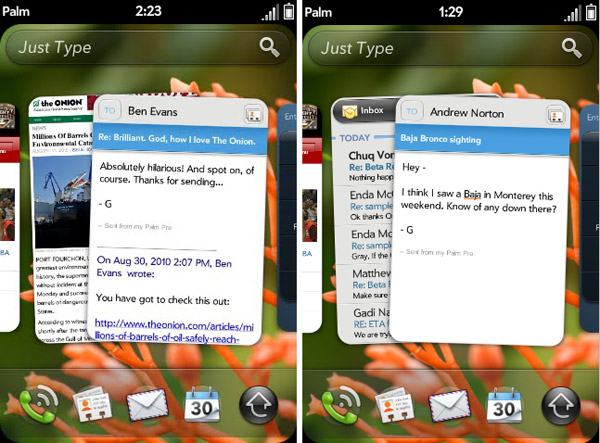Palm announced the pre-release of webOS 2.0 SDK

Today is a significant day in the life of every Palm fan. The company announced the release of the beta release of its SDK for webOS 2.0, which can only mean one thing - we are very close to releasing webOS 2.0 devices on board. Who knows, maybe it is on the basis of this OS that a revolutionary device will be created. The release stated that access to the SDK will receive a special group of developers, which will be the first to feel the SDK for the most important and advanced mobile operating system of the company. The new axis brings new interesting features into our lives, a brief overview of which is presented below.
Stacks is one of the most important innovations of the Palm, what they call “correct multitasking” (a nod to other companies, with their vision of “correct multitasking”). The principle of multitasking is called Stacks ( card stacks ) - stacks that automatically group similar applications during operation. For example, if you went through email links, then these two applications will be merged into a single stack element as part of the same process. You can move the processes yourself, but the function will try to save you from this need.
')
Just type - Palm renamed the classic webOS search to “Just type” (“just dial”) and opened a special API for developers, allowing you to connect external search engines, making it possible to search both inside the device applications and on the Internet. With the help of the new search, developers have the opportunity to use the so-called " Quick Actions " ("Quick actions"), allowing you to combine several actions using one command (some analogue of aliases and pipes in unix-like systems). With this technology it will be possible, for example, to write a message, update the status on twitter and search your favorite sites without launching the application (or applications).
Exhibition - the company mobilizes Touchstone- charging, giving it more useful properties, in addition to the nice appearance. Using the 2.0 SDK, developers will be able to program individual components of their applications, which are enabled only when the phone is installed in the dock. This means that the user will be able to select several mini-applications (for example, photo slideshow, weather, clock, as well as any combination of the above), which will be displayed on the device screen during charging.
Synergy improvements - developers can now get directly into Synergy by manually creating contact books, instant messaging services, and calendar events for the applications they create. In Palm, they say that developers will be able to create instant messengers that can exchange data with existing profiles, opening up several interesting features for those who use several services at once. Developers will also be able to simplify the procedure for adding contacts and calendar auto events that other Synergy applications generate.
Improved HTML5 support - Palm claims improved HTML5 support in webOS 2.0, including improved support for image processing, gradients in Canvas, the ability to store session data locally, support geolocation, and application-level cache (to save data offline).
JavaScript services - now the node.js environment ( asynchronous server javascript ) will be available for developers, which means that developers can use the growing database of API methods and libraries that allow implementing low-level network functionality, access to system functions and binary data processing.
PDK plug-ins - the PDK plug-in comes out of the beta stage and is fully integrated into the SDK / OS, allowing developers to more easily port software logic from other platforms (according to the company). Developers will be able to combine PDK-based functions with a large number of Palm Mojo elements, which means that you can apply PDK functionality when you need OpenGL graphics support inside creating a mobile HTML / CSS application for Palm.
As you can see, the new version of the OS brings with it a lot of interesting features and many of them have not yet been announced. The support of the now fashionable node.js looks very interesting, the support of PDK also seems to be a tasty one. It turns out this giko-oriented OS, which will be no less interesting to users. Let's see what happens.
Source: https://habr.com/ru/post/103203/
All Articles